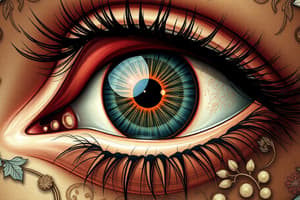Podcast
Questions and Answers
What is a normal position of the lids in relation to the iris?
What is a normal position of the lids in relation to the iris?
- 1mm above the top of iris
- 1mm below the bottom edge of iris
- 2mm below the top of iris (correct)
- 2mm above the bottom edge of iris
What is a characteristic of a normal conjunctiva?
What is a characteristic of a normal conjunctiva?
- Translucent and avascular
- Translucent and vascular (correct)
- Thick and avascular
- Thick and vascular
What does the crystalline lens lie behind?
What does the crystalline lens lie behind?
- Pupil
- Cornea
- Iris (correct)
- Sclera
What is an abnormal finding in the anterior chamber?
What is an abnormal finding in the anterior chamber?
What is a characteristic of a normal cornea?
What is a characteristic of a normal cornea?
What is an abnormal finding in the iris?
What is an abnormal finding in the iris?
What is a normal finding in the conjunctiva?
What is a normal finding in the conjunctiva?
What is a characteristic of Horner's syndrome?
What is a characteristic of Horner's syndrome?
What is an abnormal finding in the lids?
What is an abnormal finding in the lids?
What is a characteristic of a normal red reflex?
What is a characteristic of a normal red reflex?
Flashcards are hidden until you start studying
Study Notes
Abnormal Eyelid Position
- Ptosis can be a sign of Horner's syndrome (subtle ptosis with miosis) and oculomotor nerve palsy (partial to complete ptosis with 'down and out' eye position and enlarged pupil)
Lids & Lashes
- Normal position: 2mm below top of iris and 2mm below bottom edge of iris
- Abnormal findings:
- Lesions
- Crusting
- Redness
- Swelling/bruising
- Lacerations
- Abnormal lid position
Conjunctiva
- Covers the inside of eyelids and sclera, but not the cornea; it's vascular
- Normal: translucent, flat, and sclera visible beneath
- Abnormal findings:
- Chemosis (edema)
- Discharge
- Subconjunctival hemorrhage
- Lacerations
- Lesions
Cornea
- A vascular circular 'window' of the eye
- Normal: clear, bright, and smooth surface
- Abnormal findings:
- Cloudy (iris may be difficult to see)
- Scarring (milky line, localized opacity)
- Foreign body
- Rust ring
- Abscess
- Laceration
Iris
- Normal: similar appearance between eyes
- Be aware of colored contact lenses (diameter)
- Abnormal findings:
- Lesions
- Tears
- Lacerations
- Prolapsed
Crystalline Lens
- Lies behind the iris, seen through the pupil
- Normal: bright, clear, and transparent with a red reflex
- Abnormal findings:
- Dull or absent red reflex
- White pupil
- Shadows in red reflex
Anterior Chamber
- Space between posterior cornea and iris, filled with aqueous fluid
- Normal: clear, bright, and deep
- Abnormal findings:
- Flat
- Shallow
- Anterior chamber Intraocular Lens (IOL)
Dry Eye
- No additional information provided
Studying That Suits You
Use AI to generate personalized quizzes and flashcards to suit your learning preferences.




